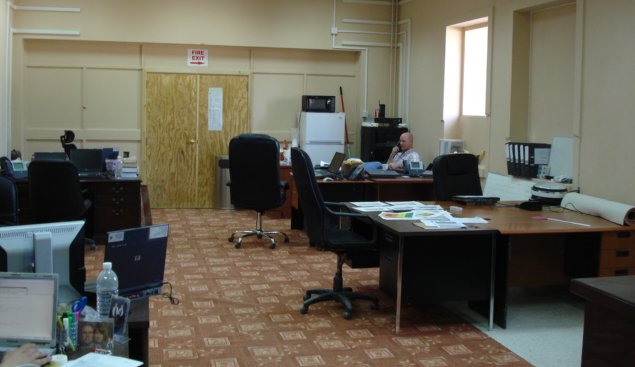We have had sandy skies that stop us from traveling and make it unpleasant to run. In general, there is not much to do around here, so I have had time on my hands to think. I have been thinking about change
I think it is important to think about these sorts of “irrelevant things”. It makes for better decisions if you have already thought through some of the boundry conditions. Anyway, below are some thoughts. Read them if you like. They are not particularly about Iraq.
Below – Separating the wheat from the chaff the old fashioned way near Rawah on the Euphrates. Some things change faster than others.

Change: Real & Imaginary
Change is constant and inevitable. Being “for change” is meaningless and childish w/o explaining what change you want & exactly how you hope to achieve it. Some people don’t understand that society is a complex system. Disturbing one thing, even a bad thing, will have unexpected consequences throughout the system.
Take a concrete example of a man dying of thirst. If you just give him as much water as he wants to drink, you probably will kill him. His body can process about a liter, maybe little more, every hour, no more. You can make changes but not on your timetable. And the most direct and “obvious” action may not be the most appropriate.
The general rules are that abrupt changes create strong reactions. There are many things you cannot have, at least at the same time, and the time lags are important in any decision.
Good leaders in our modern complex systems are catalysts for change. I say catalysts because that is often the best way for government to effect change. It allows the people themselves to decide the details and do the actual innovating. The nation and the state are not the same things. Conservatives recognize that most effective and constructive change comes from citizens, scientists and entrepreneurs, less often from command and control of politicians and bureaucrats (like me – good cautionary tale).
Politicians outline tidy programs that purport to create comprehensive and well-planned solutions. The untidy fact that they often choose to ignore is that when people are free to pursue happiness the usually do not want the same things the planners think they should.
The private sector is the source of almost all innovations. Here I have to point to the difference between innovation and basic research which often depends on government resources and rightfully so. Basic research creates options. Innovation involves taking those options and packaging or developing them into something people want. The process is not automatic. There are many examples of societies possessing some great knowledge and never creating the innovations that put it to practical use.
(Of course government can innovate within government when there is a similar competitive environment for those sorts of ideas. In the ancient world, we had Greek city states, with their various mixes of democracy, oligarchy, monarchy and tyranny. In our times, U.S. states are good examples.The ancient Romans had the basics of things like steam engines, engineering skills and water power networks, but never made the jump to the industrialization. In the late 18th Century, the Chinese had the requisite skills to make intricate machines, but used those skills to make mechanical novelties for the Mandarins. Whole books have been written about why the Middle East just stopped innovating about 400 years ago, after making a real promising start. Getting innovation out of the lab, into the workshop and out in the market is not easy and it is not been the most common thing in world history.
What often seems to be the common denominator is that a powerful centralized state, w/o significant competitors, stifles innovation. Conversely, messy, contentious and competitive systems with loose connections produce innovation.
The United States has been extraordinarily innovative following this general pattern. Our states have been the laboratories of democracy. Good innovations are copied; bad ones are limited. Our free market welcomes ideas, and for most of our history people, from around the world. Foreigners often brag that their particular former citizens create so much innovation in the U.S. The interesting question is why they had to come to the U.S. to do that.
We have enjoyed this wonderful system for a long time now. Nevertheless, it is possible mess it up.
So when some politician promises change, it might be a good idea to inquire re the type of change he is proposing AND the mechanism he plans to use to achieve it. Emperors in Rome and China (as well as lots of other places) were confident in their ability to order change. As a result, not much changed in these places over the course of hundreds or thousands of years. If you were the emperor, life was okay. The guy covered in sh*t using the same basic technologies for a thousand years was probably less enthusiastic.
Change directed from the top was not the change they could believe in.
Adam Smith published the “Wealth of Nations” in 1776. He was not so much advocating an ideal system as describing the one that was emerging in the Atlantic world. It was the beginning of the market system where diverse communities were linked by an emerging world market, where governments did believe they had the right to regulate every aspect of life and the economy, as they had in most places whenever they could since the dawn of history. For the first time in history, a large number of people came to believe that THEY owned the government rather than the other way around and an autonomous private sector was developing. It was a new paradigm, which conveniently coincided with the birth of the novus ordo seclorum that same year.
Even after 233 years, the old paradigm dies hard. It is very difficult for most people to think systemically. We are accustomed to hierarchy where somebody is in charge. In a market economy, lots of people have influence, in a state of constant change, but nobody is in charge.
We perhaps can understand it better now that we have things like Internet and Wikis. Who commands those things? I read an interesting book “The Starfish and the Spider” here the author talked about investors demanding to see the “President of the Internet”
The ancient Greek philosopher Heraclites used to say that everything flows (πάντα ρει) and graphically illustrated his point by explaining that nobody could step twice into the same river. Flowing water is an excellent way to understand change, the time it takes and the unexpected consequences of making changes. You shore up one bank with rocks, only to find that the current undercuts someplace else. You clear a channel and find two weeks later that you have changed the course of the stream a half mile UPstream. How can that happen? The simple direct solution is usually wrong and often the person who seems most in charge isn’t. He just talks the loudest – a good lesson for those who want to mess with markets.
You CAN make changes to a system like a market, just like you can to a stream. The trick is to make haste slowly. It is usually better to remove obstacles than to try to push more of your own energy into the system with direct solutions. With this approach, you often do not get what you expected. Usually it is better.






















